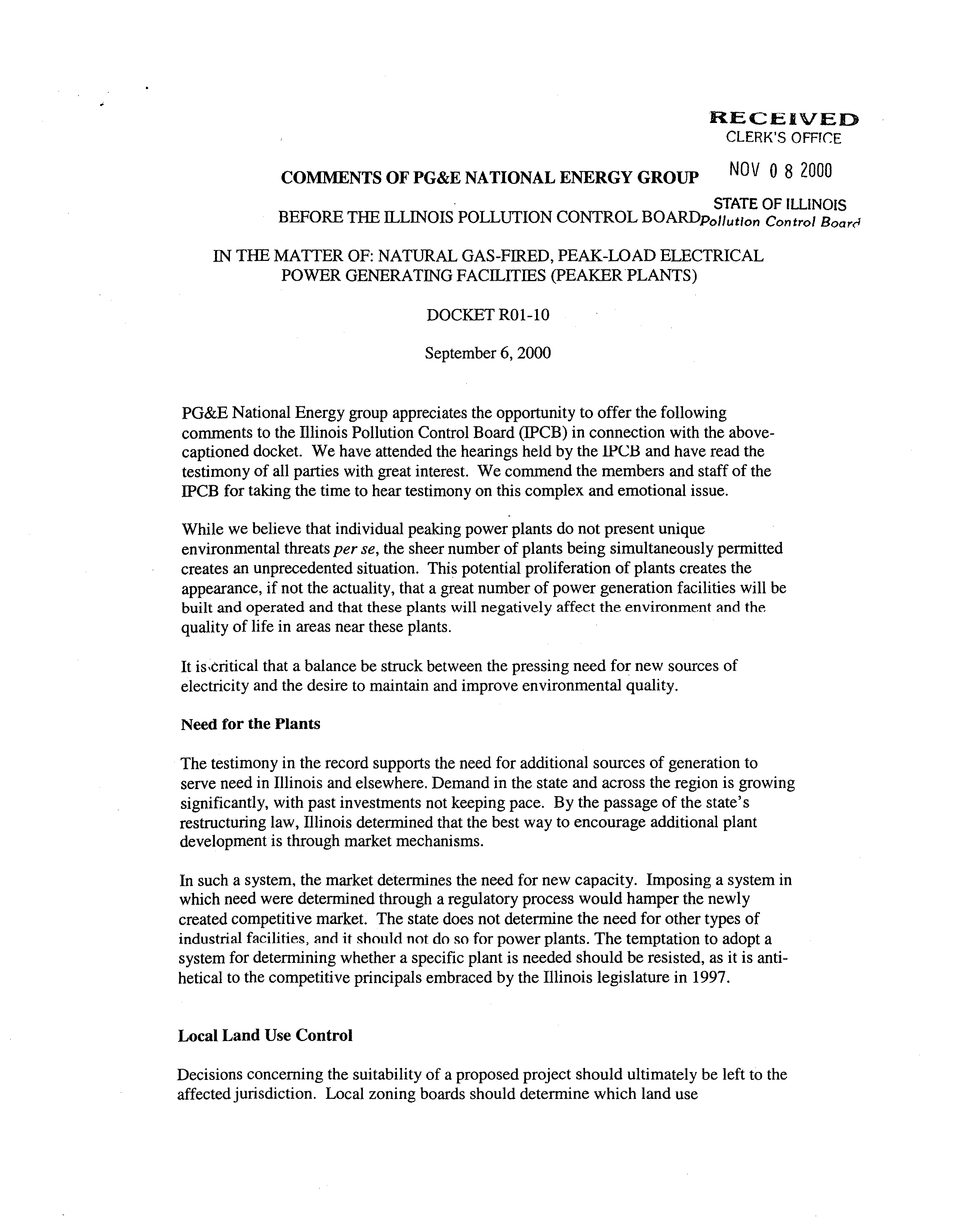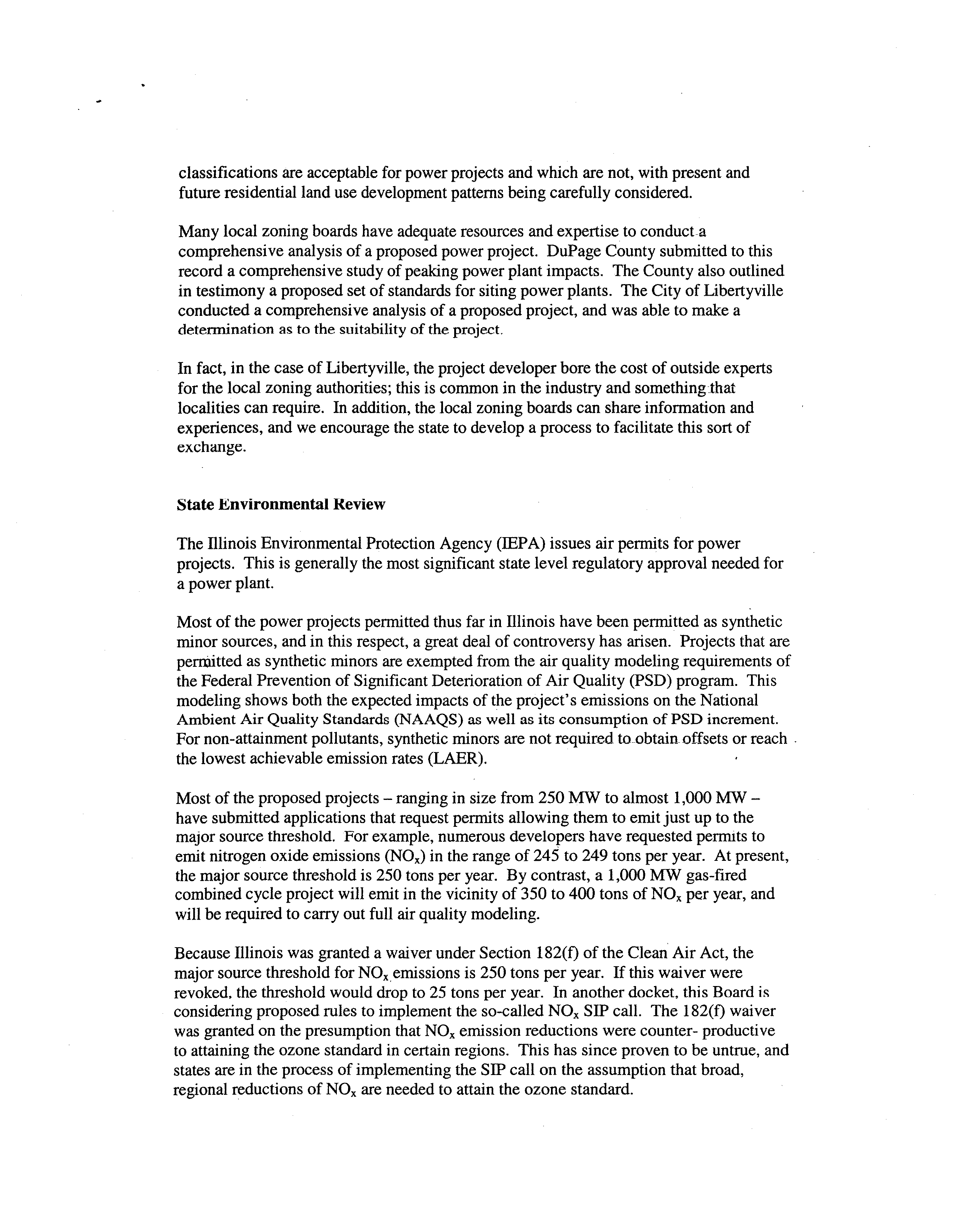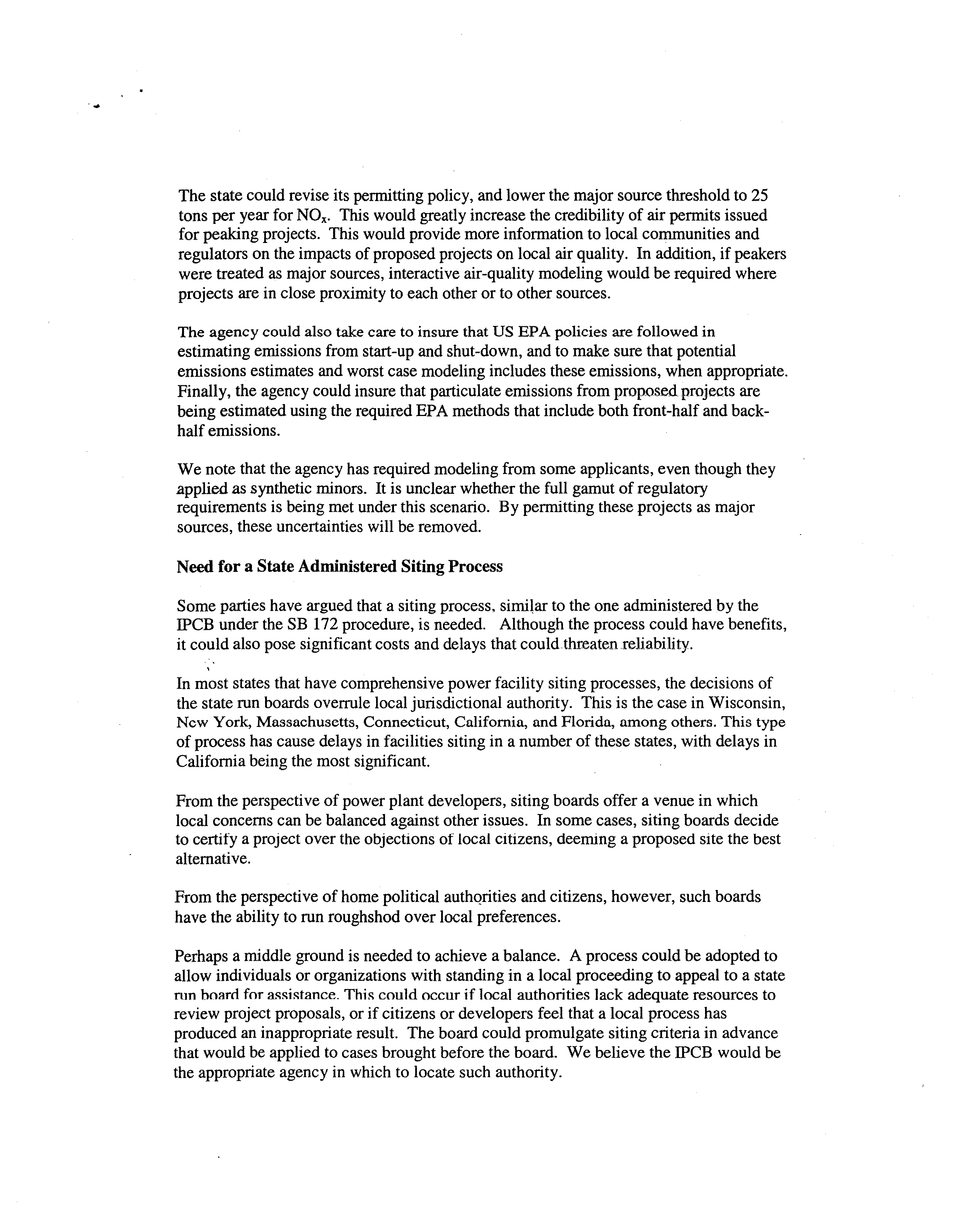(iG&E
National
Energy
&:
)
November 6, 2000
Dorothy Gunn, Clerk
Illinois Pollution Control Board
100 West Randolph Street, Suite 11-500
Chicago, IL
60601
Dear Ms. Gunn:
RECEIVED
CLERK’S OFF1C~
East Mifflin Street
cite 905
Madison, WI
53703
NOV
0
8
2000
~
Fax:
608.2562275
STATE
OF IWNOIS
Pollution
Control Board
Please find enclosed one original and five copies of comments by PG&E National Energy
Group in DocketROl-lO concerning peaking power plants.
Please contact me if there is need for clarification or for further information.
Thank you very much.
Sincerely,
Stephen Brick
Director, External Relations andEnvironmental Affairs
RECEIVED
CLERK’S
OFFTCE
COMMENTS
OF PG&E NATIONAL ENERGY GROUP
NOV
082000
STATE OF IWNOIS
BEFORE THE ILLINOIS POLLUTION
CONTROL
BOARDp0~~~t,0~
Control
BOar(J
IN TIlE MATITER OF: NATURAL GAS-FIRED, PEAK-LOAD ELECTRICAL
POWER GENERATING FACILITIES (PEAKER
PLANTS)
DOCKET
ROl-lO
September 6, 2000
PG&E National Energy group appreciates the opportunity to offer the following
comments to the illinois Pollution Control Board (IPCB) in connection with the above-
captioned docket.
We have attended the hearings held by the IPCB and have read the
testimony of all parties with great interest.
We commend the members and staff of the
IPCB fortaking the time to hear testimony on this complex and emotional issue.
While we believe that individual peaking power plants do not present unique
environmental threats
per Se,
the sheer number of plants being simultaneously permitted
creates an unprecedented situation.
This potential proliferation of plants creates the
appearance, ifnot the actuality, that a great number of power generation facilities will be
built and operated and that these plants will negatively affect the environment and the
quality of life in areas near these plants.
It is~Critical
that abalance be struck between the pressing need for new sources of
electricity and the desire to maintain and improve environmental quality.
Need
for the
Plants
The testimony in the record
supports the need for additional sources of generation to
serve need in Illinois and elsewhere. Demand in the state and across the region is growing
significantly, with past investments not keeping pace.
By the passage of the state’s
restructuring law, illinois determined that the best way to encourage additional plant
developmentis through market mechanisms.
In such asystem, the market determines the need for new capacity.
Imposing a system in
which need were determined through a regulatory process would hamper the newly
created competitive market.
The state does not determine the need for other types of
industrial facilities,
and it should not do so for power plants. The temptation to adopt a
system for determining whether aspecific plant is needed should be resisted, as
it is anti-
hetical to the competitiveprincipals embraced by the Illinois legislature in 1997.
Local Land Use Control
Decisions concerning the suitability of a proposed project should ultimately be left to the
affectedjunsdiction.
Local zoning boards should determine which landuse
classifications are acceptable for power projects and which are not, with present and
future residential land use development patterns being carefully considered.
Many local zoning boards have adequate resources and expertise to conduct-a
comprehensive analysis of a proposed power project.
DuPage County submitted to this
record a comprehensive studyof peaking power plant impacts.
The County also outlined
in testimony aproposed set of standards for siting power plants.
The City of Libertyville
conducted a comprehensive analysis of a proposed project, and was
able to make a
determination
as
to the suitability of the project.
In fact, in the case of Libertyville, the project developer bore the cost of outside experts
for the local zoning authorities; this is common in the industry and something-That
localities can require.
In addition, the local zoning boards can share information and
experiences, and we encourage the state to develop a process to facilitate this sort of
exchange.
State
Environmental Review
The illinois Environmental Protection Agency (IEPA) issues air permits for power
projects.
This is generally the most significant state level regulatory approval needed for
apower plant.
Most of the power projects permitted thus far in illinois have been permitted
as synthetic
minor sources, and in this respect, a great deal of controversy has arisen.
Projects that are
permitted as synthetic minors
are exempted from the air quality modeling requirements of
the Federal Prevention of Significant Deterioration of Air Quality (PSD) program.
This
modeling shows both the expected impacts of the project’s emissions on the National
Ambient Air Quality Standards
(NAAQS) as well as its consumption of PSD increment.
For non-attainment pollutants, synthetic minors are not required to obtain offsets or reach
the lowest achievable emission rates (LAER).
Most of the proposed projects
—
ranging in size from 250 MW to almost 1,000MW
—
have submitted applications that request permits allowing them to emitjust up to the
major source threshold.
For example, numerous developers have requested permits to
emit nitrogen oxide emissions (NOr) in the range of
245
to 249 tons per year.
At present,
the major source thresholdis 250 tons per year.
By contrast, a 1,000 MW gas-fired
combined cycle project will emit in the vicinity of
350
to 400 tons of NO~
per year, and
will be required to carry out full air quality modeling.
Because Illinois was
granteda waiver under Section 182(f) of the Clean Air Act, the
major source threshold forNO~
emissions is 250 tons per
year.
If this waiver were
revoked, the threshold would drop to 25 tons per
year.
In another docket, this Board is
considering proposed rules to implement the so-called NO~
SIP call.
The 182(f) waiver
was granted on the presumption that NO~
emission reductions were counter- productive
to attaining the ozone standard in certain regions.
This has since proven to be untrue, and
states are in the process of implementing the SiP call on
the assumption that broad,
regional reductions of NO~
are needed to attain the ozone standard.
The state could revise its permiuing policy, and lower the major sourcethreshold to 25
tons per yearfor NOR.
This would greatly increase the credibility of air permits issued
forpeaking projects.
This would provide more information to local communities and
regulators on the impacts of proposed projects on
local air quality.
In addition, ifpeakers
were treated as major sources, interactive air-quality modeling would be required where
projects are in close proximity to each other or to other sources.
The agency could also take care to insure that US EPA policies are followed in
estimating emissions from start-up and shut-down, and to make sure that potential
emissions estimates and worst case modeling includes these emissions, when appropriate.
Finally, the agency could insure that particulate emissions from proposed projects are
being estimated using the required EPA methods that include both front-half andback-
halfemissions.
We note that the agency has required modeling from some applicants, even though they
applied as synthetic minors.
It is unclear whether the full gamut of regulatory
requirements is being met under this scenario.
By permitting these projects as major
sources, these uncertainties will be removed.
Need
for a State Administered Siting Process
Some parties have argued that a siting process, similar to the one administered by the
IPCB under the SB 172 procedure, is needed.
Although the process could have benefits,
it could also pose significant costs anddelays that couldthreaten reliability.
In most states that have comprehensive power facility siting processes, the decisions of
the state run boards overrule local jurisdictional authority.
This is the case in Wisconsin,
Now York, Massachusetts, Connecticut,
California, andFlorida,
among others. This type
of process has cause delays in facilities siting in a number of these states, with delays
in
California being the most significant.
From the perspective of power plant developers, siting boards offer a venue in which
local concerns can be balanced against other issues.
In some cases, siting boards decide
to certify aproject over the objections of local citizens, deeming a proposed site the best
alternative.
From the perspective of home political authorities and citizens, however,
such boards
have the ability to run roughshod over local preferences.
Perhaps a middle ground is needed to achieve abalance.
A process could be adopted to
allow individuals or organizations with standing in alocal proceeding to appeal to a state
nrn
board for
assistance
This could occur if local
authorities lack adequate resources to
review project proposals, or ifcitizens or developers feel that a local process has
produced an inappropriate result.
The board could promulgate siting criteria in advance
that would be applied to cases brought before the board.
We believe the IPCB would be
the appropriate agency in which to locate such authority.




